1996 NISSAN MAXIMA belt
[x] Cancel search: beltPage 46 of 197
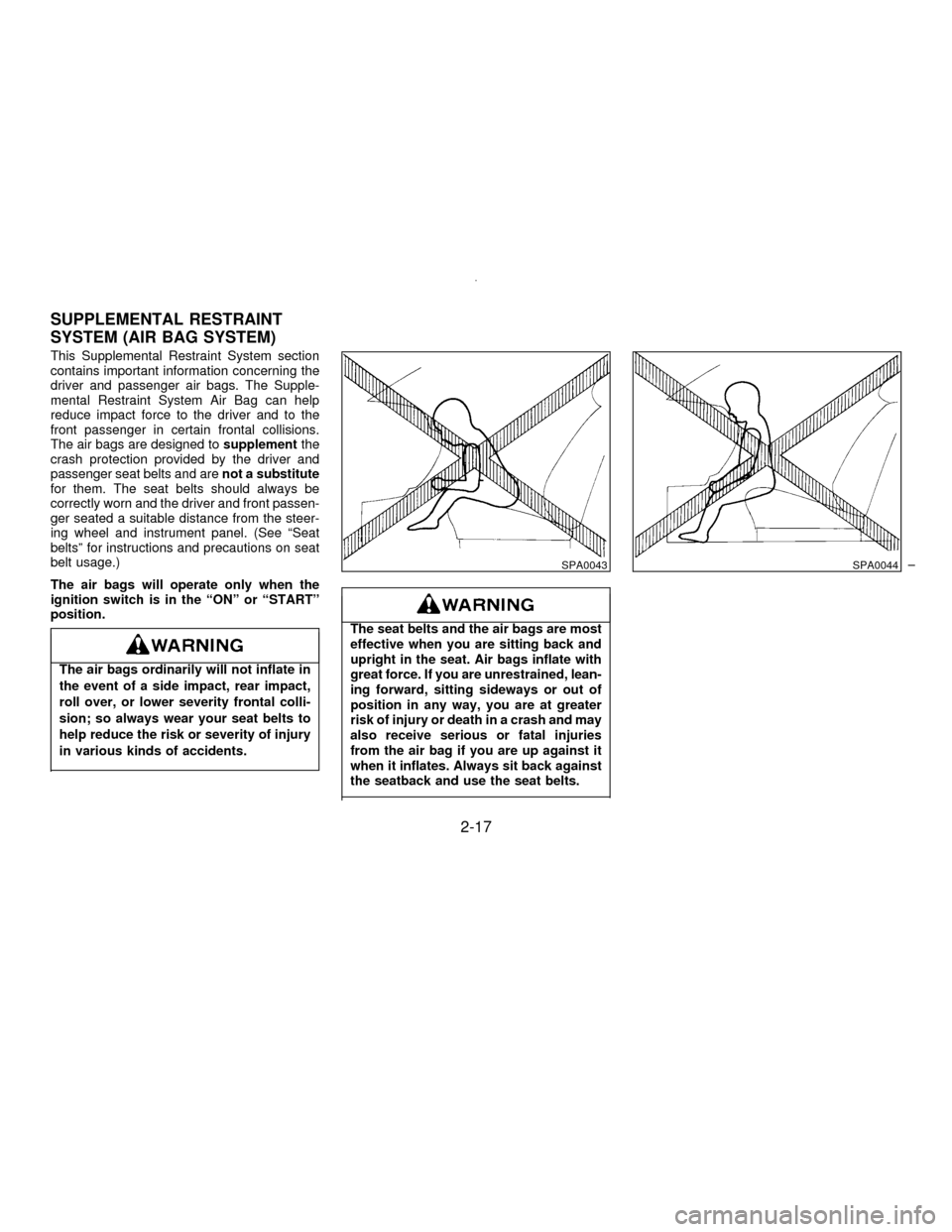
This Supplemental Restraint System section
contains important information concerning the
driver and passenger air bags. The Supple-
mental Restraint System Air Bag can help
reduce impact force to the driver and to the
front passenger in certain frontal collisions.
The air bags are designed tosupplementthe
crash protection provided by the driver and
passenger seat belts and arenot a substitute
for them. The seat belts should always be
correctly worn and the driver and front passen-
ger seated a suitable distance from the steer-
ing wheel and instrument panel. (See ªSeat
beltsº for instructions and precautions on seat
belt usage.)
The air bags will operate only when the
ignition switch is in the ªONº or ªSTARTº
position.
The air bags ordinarily will not inflate in
the event of a side impact, rear impact,
roll over, or lower severity frontal colli-
sion; so always wear your seat belts to
help reduce the risk or severity of injury
in various kinds of accidents.
The seat belts and the air bags are most
effective when you are sitting back and
upright in the seat. Air bags inflate with
great force. If you are unrestrained, lean-
ing forward, sitting sideways or out of
position in any way, you are at greater
risk of injury or death in a crash and may
also receive serious or fatal injuries
from the air bag if you are up against it
when it inflates. Always sit back against
the seatback and use the seat belts.
SPA0043SPA0044
SUPPLEMENTAL RESTRAINT
SYSTEM (AIR BAG SYSTEM)
2-17
Z01.2.1/A32-DX
Page 48 of 197
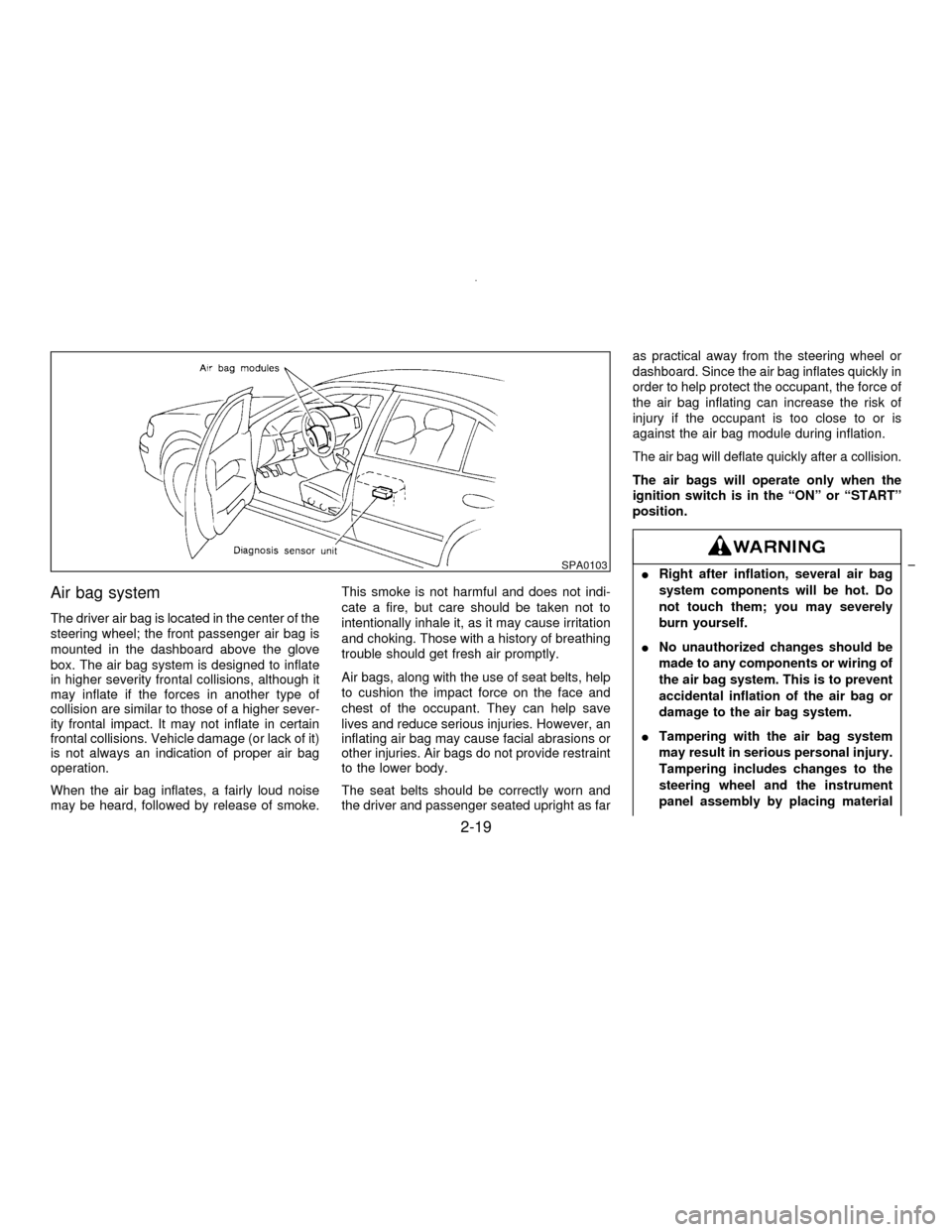
Air bag system
The driver air bag is located in the center of the
steering wheel; the front passenger air bag is
mounted in the dashboard above the glove
box. The air bag system is designed to inflate
in higher severity frontal collisions, although it
may inflate if the forces in another type of
collision are similar to those of a higher sever-
ity frontal impact. It may not inflate in certain
frontal collisions. Vehicle damage (or lack of it)
is not always an indication of proper air bag
operation.
When the air bag inflates, a fairly loud noise
may be heard, followed by release of smoke.This smoke is not harmful and does not indi-
cate a fire, but care should be taken not to
intentionally inhale it, as it may cause irritation
and choking. Those with a history of breathing
trouble should get fresh air promptly.
Air bags, along with the use of seat belts, help
to cushion the impact force on the face and
chest of the occupant. They can help save
lives and reduce serious injuries. However, an
inflating air bag may cause facial abrasions or
other injuries. Air bags do not provide restraint
to the lower body.
The seat belts should be correctly worn and
the driver and passenger seated upright as faras practical away from the steering wheel or
dashboard. Since the air bag inflates quickly in
order to help protect the occupant, the force of
the air bag inflating can increase the risk of
injury if the occupant is too close to or is
against the air bag module during inflation.
The air bag will deflate quickly after a collision.
The air bags will operate only when the
ignition switch is in the ªONº or ªSTARTº
position.
IRight after inflation, several air bag
system components will be hot. Do
not touch them; you may severely
burn yourself.
INo unauthorized changes should be
made to any components or wiring of
the air bag system. This is to prevent
accidental inflation of the air bag or
damage to the air bag system.
ITampering with the air bag system
may result in serious personal injury.
Tampering includes changes to the
steering wheel and the instrument
panel assembly by placing materialSPA0103
2-19
Z01.2.1/A32-DX
Page 52 of 197

PRECAUTIONS ON SEAT BELT
USAGE
Your chances of being injured or killed in an
accident and/or the severity of injury may be
greatly reduced if you are wearing your seat
belt and it is properly adjusted. NISSAN
strongly encourages you and all of your pas-
sengers to buckle up every time you drive,
even if your seating position includes an air
bag.
Some states, provinces or territories re-
quire that seat belts be worn at all times
when a vehicle is being driven.
IEvery person who drives or rides in
this vehicle should use a seat belt at
all times. Children should be in ap-
propriate child restraints.
IThe belt should be adjusted properly
and to a snug fit. Failure to do so will
reduce the effectiveness of the entire
restraint system and increase the
chance or severity of injury in an
accident.
IDo not wear the belt inside out ortwisted. Be sure the seat belt tongue
is securely fastened to the proper
buckle.
IDo not allow more than one person to
use the same belt.
IAll seat belt assemblies including re-
tractors and attaching hardware
should be inspected by your NISSAN
dealer after any collision. NISSAN
recommends that all seat belt assem-
blies in use during a collision be
replaced unless the collision was mi-
nor and the belts show no damage
and continue to operate properly.
Seat belt assemblies not in use dur-
ing a collision should also be in-
spected and replaced if either dam-
age or improper operation is noted.
INever carry more people in the ve-
hicle than there are seat belts.
If the seat belt warning lamp glows con-
tinuously while the ignition is turned
ªONº with all doors closed and all seat
belts fastened, it may indicate a mal-
function in the system. Have the system
checked by your NISSAN dealer.Be sure to observe the following cau-
tions when using seat belts. Failure to
do so could increase the chance and/or
severity of injury in an accident.
IAlways route the shoulder belt over
your shoulder and across your chest.
Never run the belt under your arm or
across your neck. The belt should be
away from your face and neck, but
not falling off your shoulder.
IPosition the lap belt as low as pos-
sible AROUND THE HIPS, NOT THE
WAIST.
ISerious injury or death can occur if
the seat belt is not worn properly.
CHILD SAFETY
Children need adults to help protect them.
All U.S. states and provinces of Canada re-
quire the use of approved child restraints for
infants and small children. (See ªChild re-
straints for infants and small childrenº later in
this section.)
In addition, there are many types of child
restraints available for larger children which
should be used for maximum protection.
SEAT BELTS
2-23
Z01.2.1/A32-DX
Page 53 of 197

Infant or small child
NISSAN recommends that infants or small
children be placed in child restraint systems
that comply with Federal Motor Vehicle Safety
Standards or Canadian Motor Vehicle Safety
Standards. You should choose a child restraint
system that fits your vehicle and always follow
the manufacturer's instructions for installation
and use.
Children
Children who are too large for child restraint
systems should be seated and restrained by
the seat belts which are provided.
NISSAN recommends that children sit in the
rear seat if possible. According to accident
statistics, children are safer when properly
restrained in the rear seat than in the front
seat.
If the child's seating position has a shoulder
belt that fits close to the face or neck, the use
of a booster seat (commercially available) may
help overcome this. The booster seat should
raise the child so that the shoulder belt is
properly positioned across the top, middle
portion of the shoulder and the lap belt is low
on the hips. The booster seat should fit the
vehicle seat and have a label certifying that it
complies with Federal Motor Vehicle SafetyStandards or Canadian Motor Vehicle Safety
Standards. Once the child has grown so the
shoulder belt is no longer on or near the face
and neck, use the shoulder belt without the
booster seat.
Never let a child stand or kneel on any seat
and do not allow a child in the cargo areas
while the vehicle is moving.
Pregnant women
NISSAN recommends that pregnant women
use seat belts. Contact your doctor for specific
recommendations. The lap belt should be
worn snug and positioned as low as possible
around the hips, not the waist.
Injured persons
NISSAN recommends that injured persons
use seat belts, depending on the injury. Check
with your doctor for specific recommendations.
2-24
Z01.2.1/A32-DX
Page 54 of 197
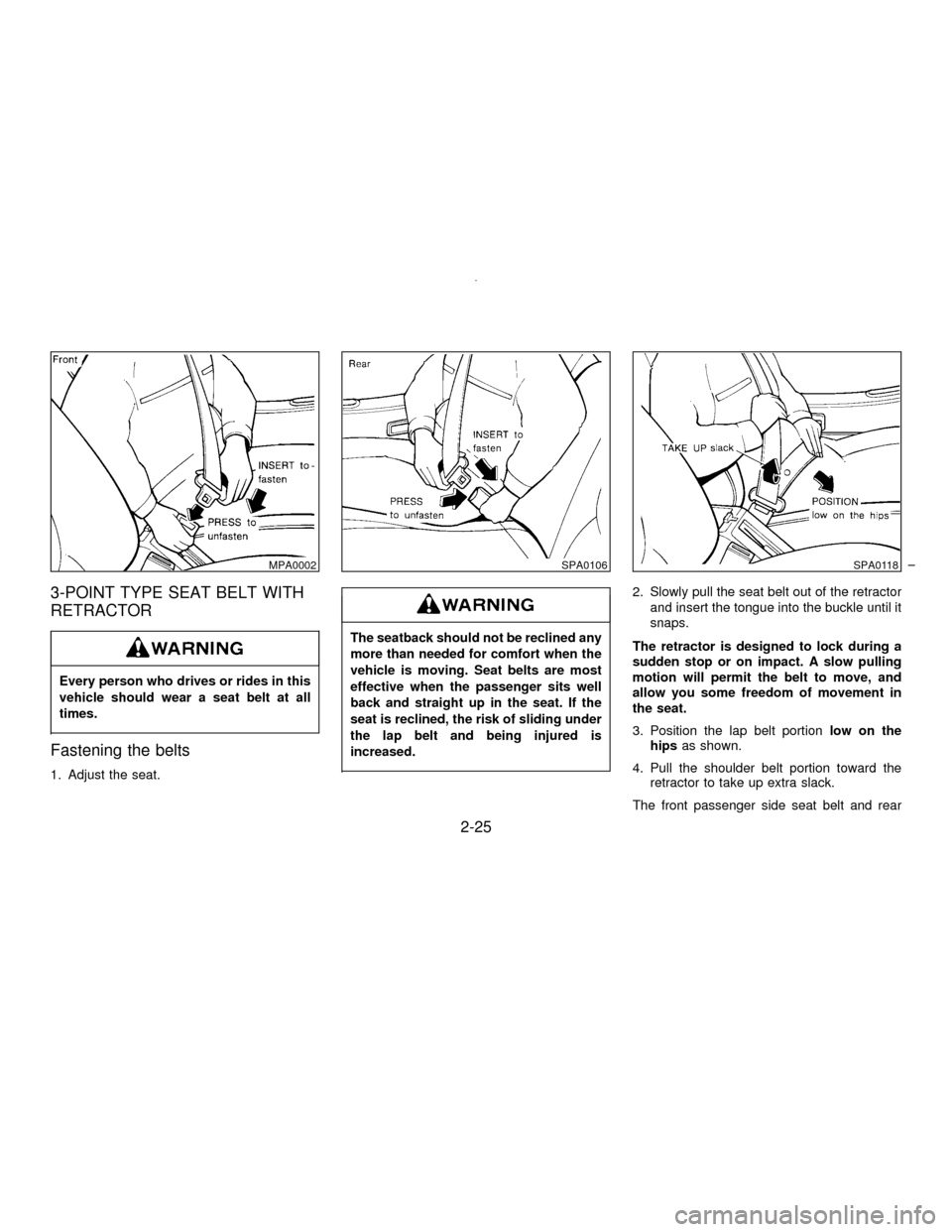
3-POINT TYPE SEAT BELT WITH
RETRACTOR
Every person who drives or rides in this
vehicle should wear a seat belt at all
times.
Fastening the belts
1. Adjust the seat.
The seatback should not be reclined any
more than needed for comfort when the
vehicle is moving. Seat belts are most
effective when the passenger sits well
back and straight up in the seat. If the
seat is reclined, the risk of sliding under
the lap belt and being injured is
increased.
2. Slowly pull the seat belt out of the retractor
and insert the tongue into the buckle until it
snaps.
The retractor is designed to lock during a
sudden stop or on impact. A slow pulling
motion will permit the belt to move, and
allow you some freedom of movement in
the seat.
3. Position the lap belt portionlow on the
hipsas shown.
4. Pull the shoulder belt portion toward the
retractor to take up extra slack.
The front passenger side seat belt and rear
MPA0002SPA0106SPA0118
2-25
Z01.2.1/A32-DX
Page 55 of 197
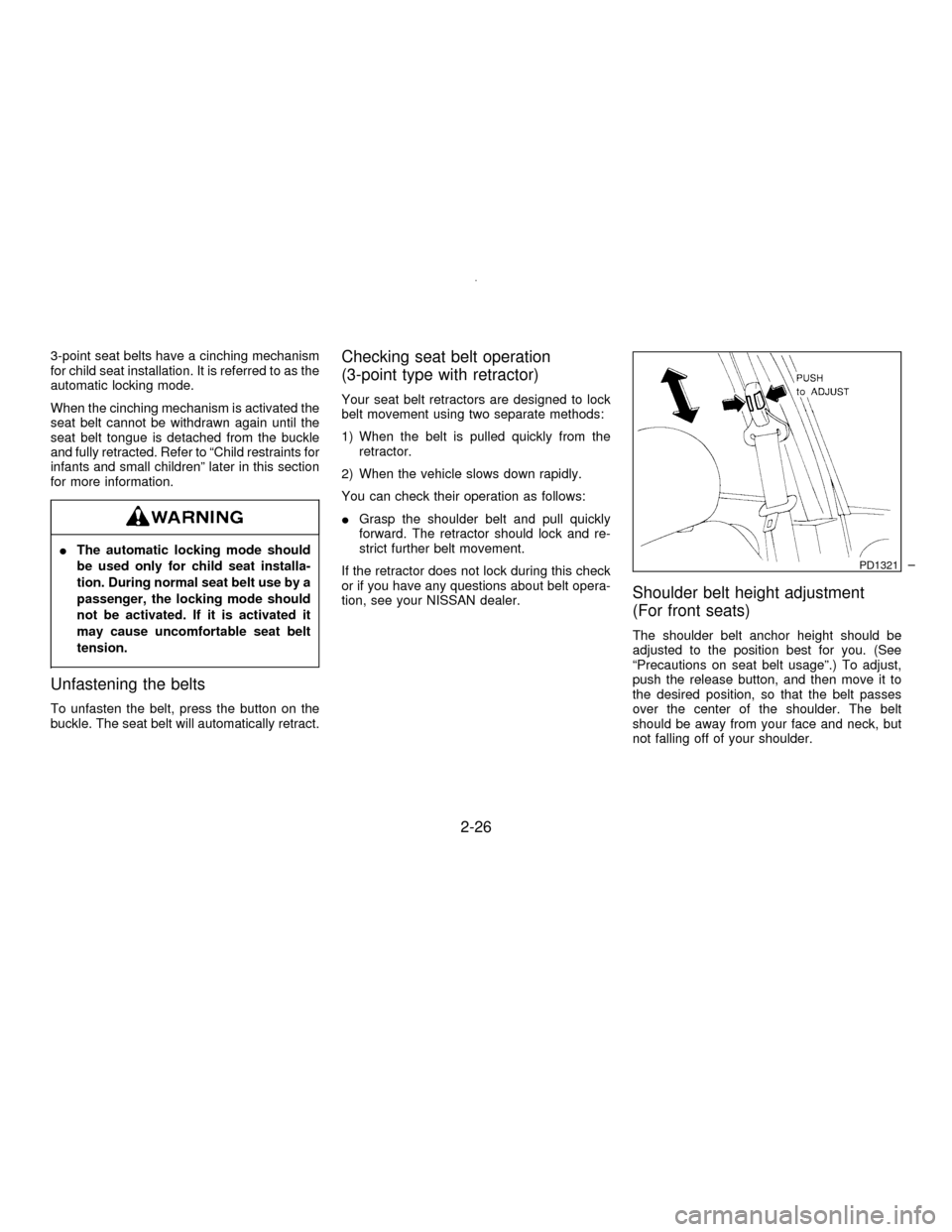
3-point seat belts have a cinching mechanism
for child seat installation. It is referred to as the
automatic locking mode.
When the cinching mechanism is activated the
seat belt cannot be withdrawn again until the
seat belt tongue is detached from the buckle
and fully retracted. Refer to ªChild restraints for
infants and small childrenº later in this section
for more information.
IThe automatic locking mode should
be used only for child seat installa-
tion. During normal seat belt use by a
passenger, the locking mode should
not be activated. If it is activated it
may cause uncomfortable seat belt
tension.
Unfastening the belts
To unfasten the belt, press the button on the
buckle. The seat belt will automatically retract.
Checking seat belt operation
(3-point type with retractor)
Your seat belt retractors are designed to lock
belt movement using two separate methods:
1) When the belt is pulled quickly from the
retractor.
2) When the vehicle slows down rapidly.
You can check their operation as follows:
IGrasp the shoulder belt and pull quickly
forward. The retractor should lock and re-
strict further belt movement.
If the retractor does not lock during this check
or if you have any questions about belt opera-
tion, see your NISSAN dealer.
Shoulder belt height adjustment
(For front seats)
The shoulder belt anchor height should be
adjusted to the position best for you. (See
ªPrecautions on seat belt usageº.) To adjust,
push the release button, and then move it to
the desired position, so that the belt passes
over the center of the shoulder. The belt
should be away from your face and neck, but
not falling off of your shoulder.
PD1321
2-26
Z01.2.1/A32-DX
Page 56 of 197
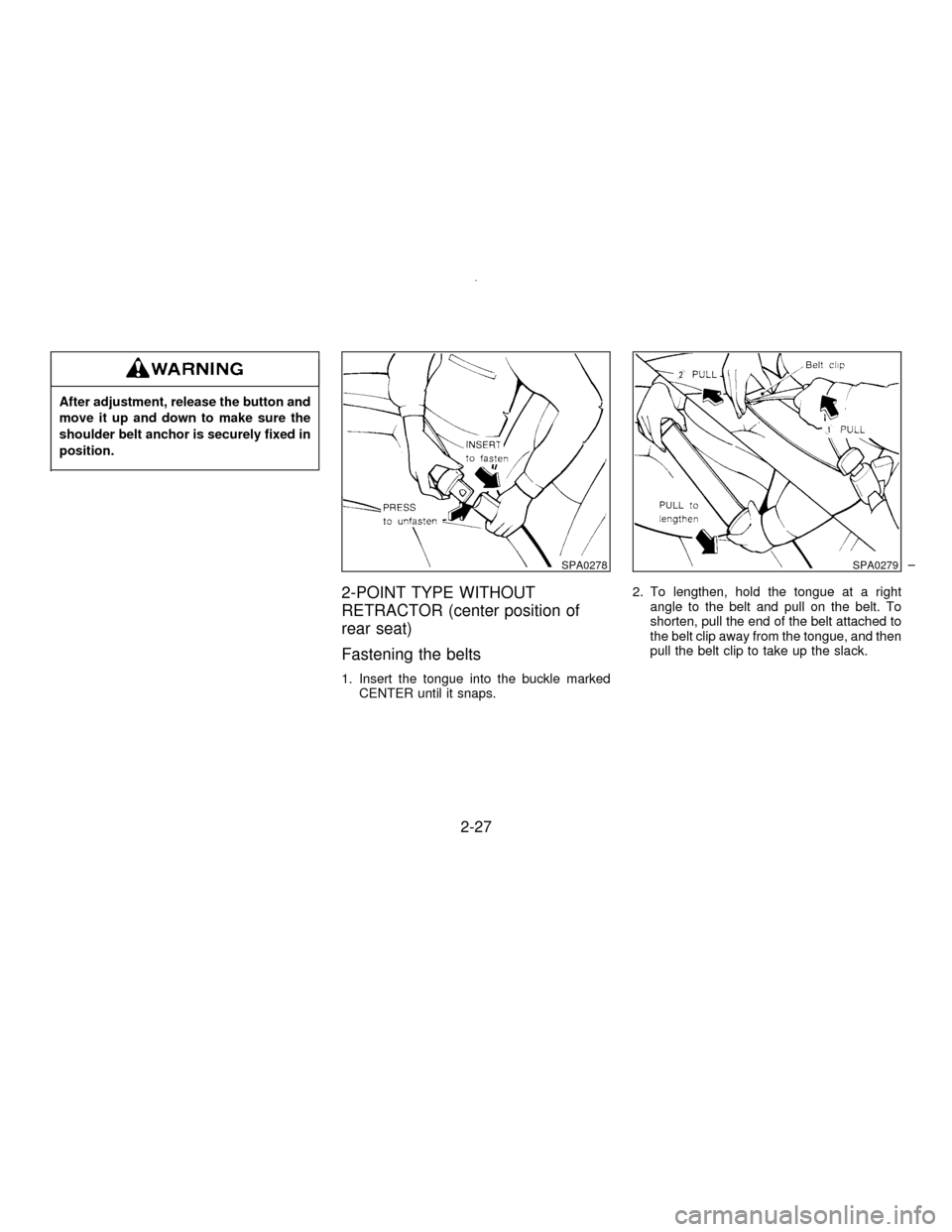
After adjustment, release the button and
move it up and down to make sure the
shoulder belt anchor is securely fixed in
position.
2-POINT TYPE WITHOUT
RETRACTOR (center position of
rear seat)
Fastening the belts
1. Insert the tongue into the buckle marked
CENTER until it snaps.2. To lengthen, hold the tongue at a right
angle to the belt and pull on the belt. To
shorten, pull the end of the belt attached to
the belt clip away from the tongue, and then
pull the belt clip to take up the slack.
SPA0278SPA0279
2-27
Z01.2.1/A32-DX
Page 57 of 197
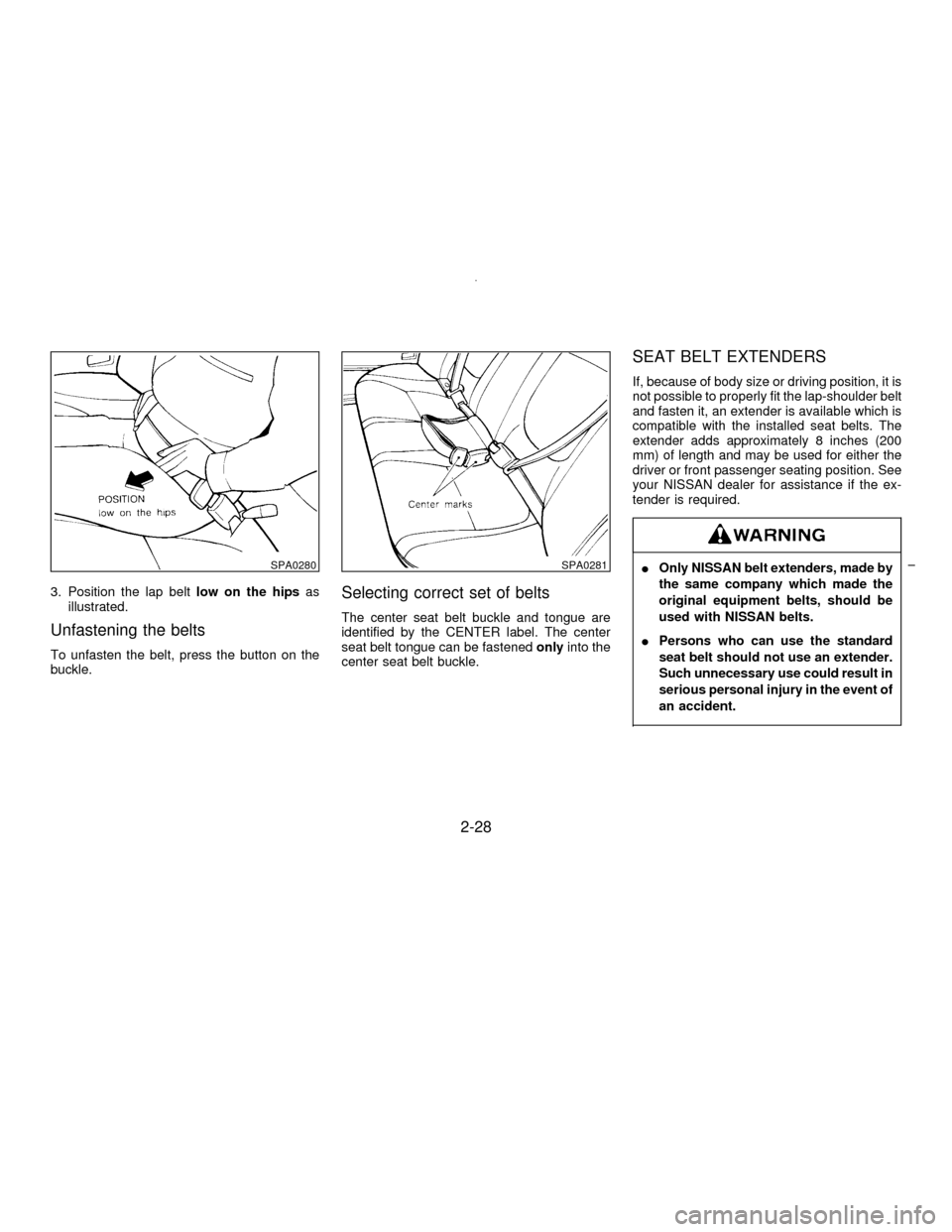
3. Position the lap beltlow on the hipsas
illustrated.
Unfastening the belts
To unfasten the belt, press the button on the
buckle.
Selecting correct set of belts
The center seat belt buckle and tongue are
identified by the CENTER label. The center
seat belt tongue can be fastenedonlyinto the
center seat belt buckle.
SEAT BELT EXTENDERS
If, because of body size or driving position, it is
not possible to properly fit the lap-shoulder belt
and fasten it, an extender is available which is
compatible with the installed seat belts. The
extender adds approximately 8 inches (200
mm) of length and may be used for either the
driver or front passenger seating position. See
your NISSAN dealer for assistance if the ex-
tender is required.
IOnly NISSAN belt extenders, made by
the same company which made the
original equipment belts, should be
used with NISSAN belts.
IPersons who can use the standard
seat belt should not use an extender.
Such unnecessary use could result in
serious personal injury in the event of
an accident.SPA0280SPA0281
2-28
Z01.2.1/A32-DX